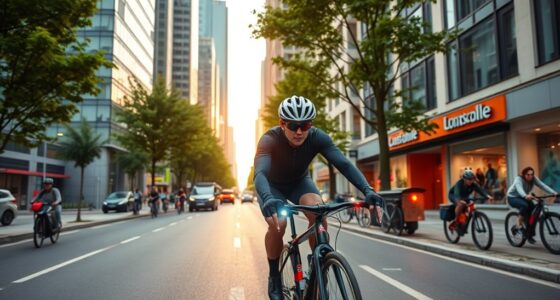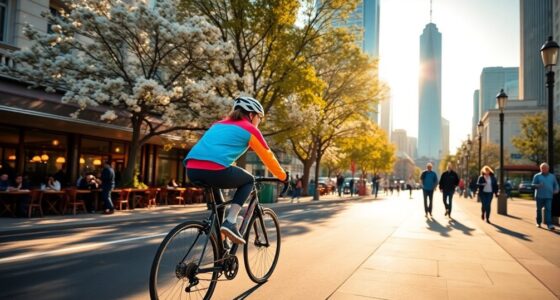To stay safe while cycling on city streets, always wear a properly fitted helmet to reduce head injuries significantly. Stay aware of your surroundings, especially at intersections and during peak traffic hours. Use reflective gear and lights to enhance visibility. Follow traffic signals and yield to pedestrians. Look for protected bike lanes, which greatly improve safety. Understanding local laws, like helmet regulations, is essential. Discover more about effective urban cycling strategies to ensure your safety.
Key Takeaways
- Always wear a properly fitted helmet to reduce head injury risk by 62% to 88% while cycling.
- Use reflective gear and lights to enhance visibility, especially during low light conditions.
- Stay alert to traffic signals and signage, and be cautious in construction zones and at intersections.
- Opt for protected bike lanes whenever possible to lower the risk of injury by about 75%.
- Familiarize yourself with local cycling laws, including helmet use and sidewalk riding regulations, for safer road compliance.
Importance of Helmet Use in Urban Cycling

While cycling in urban environments can be exhilarating, the importance of wearing a helmet can't be overstated.
Studies show that helmets reduce the risk of head injuries by 62% to 88%, significantly lowering the chances of traumatic brain injuries. You'll also find that wearing a helmet can decrease your risk of skull fractures by up to 98%.
Helmets can reduce head injury risk by 62% to 88% and lower skull fracture chances by up to 98%.
Moreover, communities with mandatory helmet laws see a reduction in cycling fatalities by about 15% over time.
Even though some controversies exist, like potential neck injuries and altered riding behavior, the benefits of helmet use clearly outweigh the risks.
Navigating Common Hazards on City Streets
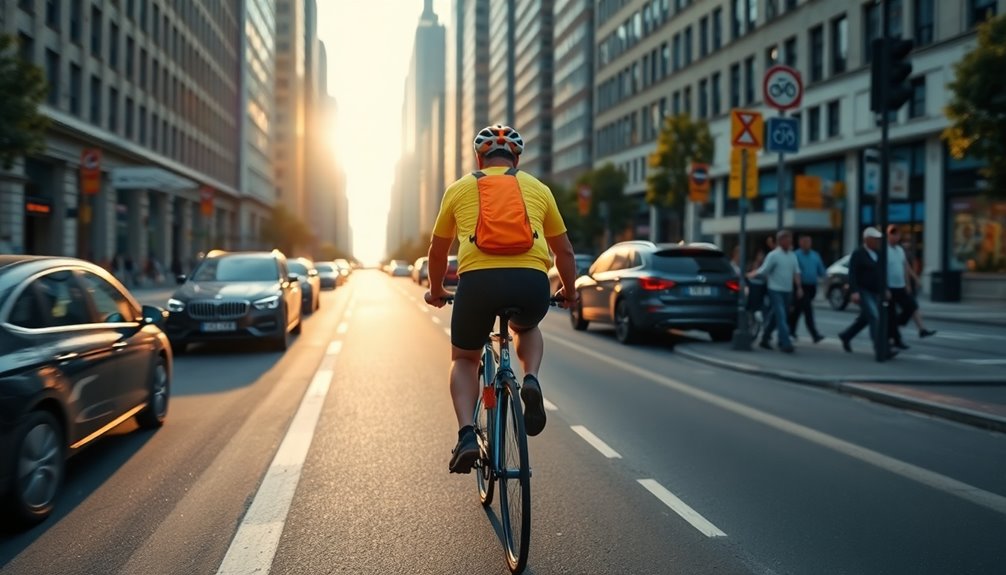
Wearing a helmet is just one part of staying safe while cycling in urban areas; knowing how to navigate the common hazards on city streets is equally important.
Be aware of peak traffic hours, as congestion can increase your risk. Pay attention to traffic signals and signage to avoid accidents.
Construction zones often cause detours and require extra caution. Watch for potholes and debris that can suddenly appear, especially on straight roads.
Intersections are particularly dangerous; always be vigilant here. Be mindful of weather conditions that can affect visibility and road safety.
Lastly, avoid alcohol before riding to keep yourself and others safe. Staying alert and informed will help you confidently navigate urban cycling hazards.
Essential Safety Measures for Cyclists

To ensure a safe cycling experience in urban environments, it's vital to equip yourself with essential safety measures.
Always wear a properly fitted helmet to reduce head injuries. Enhance your visibility with reflective gear and front and rear lights, especially in low light.
Utilize mirrors to keep an eye on traffic without turning your head constantly. Remember to follow traffic signals and ride with traffic for predictability.
Yield to pedestrians and use hand signals to communicate your intentions clearly. Stay alert to your surroundings and avoid distractions like mobile phones.
Regularly check your bike's brakes and tires, and maintain a steady pace to avoid sudden movements.
The Role of Infrastructure in Cycling Safety
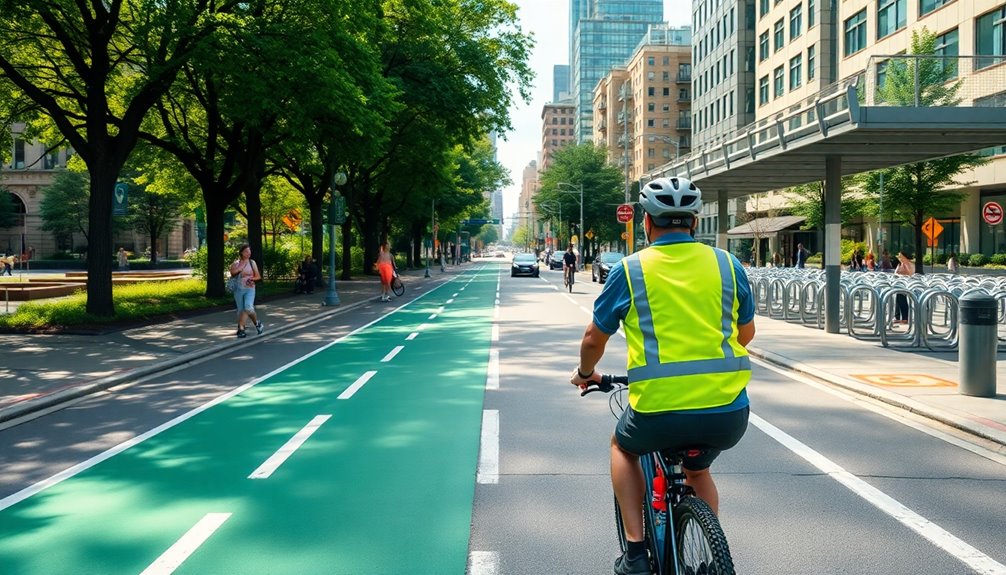
Infrastructure plays a crucial role in enhancing cycling safety, particularly in urban areas where traffic can be overwhelming. Protected bike lanes are a game changer, reducing bike-related intersection injuries by about 75%.
When cities expand their bike networks, not only does ridership increase, but safety improves significantly. These lanes separate you from fast-moving traffic, making your ride less stressful.
Cyclists report feeling safer on protected lanes, with a 90% positive response in places like Pennsylvania Ave. Moreover, by reducing sidewalk riding, these lanes improve safety for everyone.
With lower traffic speeds and better traffic flow management, investing in cycling infrastructure creates a safer environment, encouraging more people to ride and boosting local economies.
Understanding Legal and Regulatory Aspects for Cyclists
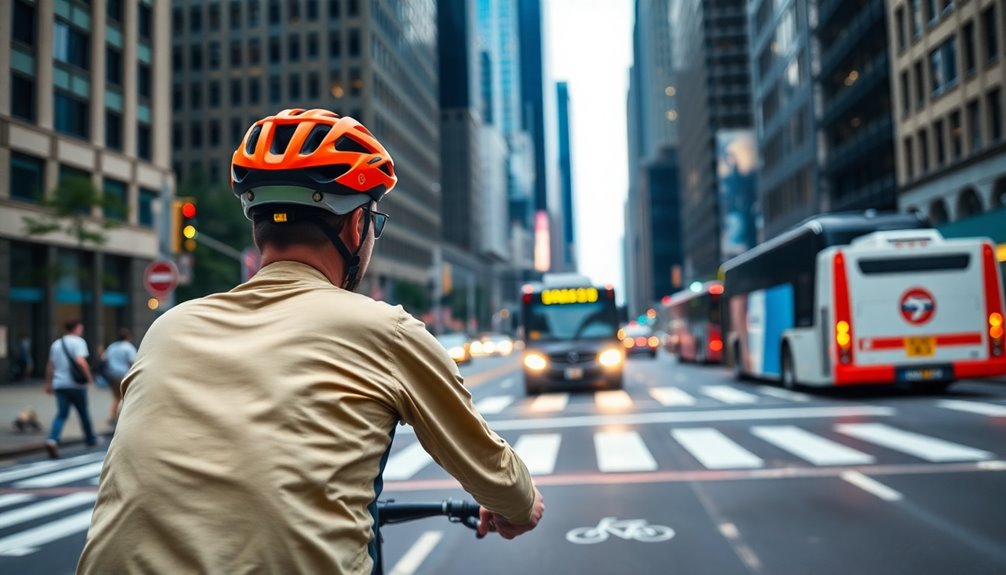
While navigating urban environments on your bike, it's essential to understand the legal and regulatory aspects that govern cycling.
In California, if you're under 18, you must wear a helmet that meets safety standards. Ensure your bike has proper lighting and reflectors, especially at night. Riding on sidewalks can vary by location, so check local laws.
Always yield to pedestrians in crosswalks and signal your turns to keep everyone safe. Remember to ride with traffic, stop at red lights, and avoid distractions.
Yield to pedestrians and signal your turns; ride with traffic, stop at red lights, and stay focused for safety.
Laws protect you as a cyclist, imposing penalties for unsafe driving around you. Familiarizing yourself with these rules not only keeps you compliant but also enhances your safety on the road.
Frequently Asked Questions
What Should I Do if I Get Into a Cycling Accident?
If you get into a cycling accident, seek immediate medical attention, even if you feel fine.
Move to a safe location to avoid further danger and assess any injuries.
Document the scene with photos, gather witness information, and exchange details with others involved.
Report the incident to local authorities for an official record, and notify your insurance provider.
Consider consulting a personal injury lawyer if injuries or damages occur.
Prioritize your safety first.
How Can I Improve My Cycling Skills for Urban Riding?
Improving your cycling skills for urban riding is like sharpening a knife—precision matters.
Start by ensuring your bike fits you perfectly for better control. Practice braking smoothly, so you stay balanced.
Ride in a straight line to boost visibility, and learn emergency maneuvers for unexpected situations. Familiarize yourself with gear selection for different terrains.
Consider taking a local course to gain confidence and connect with fellow cyclists who can share valuable tips.
Are There Specific Bike Brands Recommended for City Cycling?
If you're looking for bike brands suited for city cycling, consider Trek for quality commuter bikes.
Rad Power offers affordable e-bikes, and Priority provides durable non-electric options.
Cannondale offers rugged urban e-bikes, while Tern provides excellent folding bikes perfect for compact living.
Each brand has features tailored to urban environments, ensuring you'll find a reliable ride for your daily commutes.
Check them out to see what fits your needs best!
What Are the Best Times to Cycle in Urban Areas?
The best times to cycle in urban areas are early morning and late evening.
You'll find less traffic during these hours, making your ride more enjoyable and safer.
Try to avoid rush hour—typically 8-9 am and 3-6 pm—when roads are congested and drivers are stressed.
Seasonal factors also matter; in summer, mornings help you beat the heat, while winter mornings offer fewer cars and more daylight.
Plan your rides accordingly!
How Can I Find Cycling Groups or Communities in My City?
Finding cycling groups in your city can be as easy as a leisurely ride or as challenging as navigating a busy intersection.
Start by searching online for local clubs, checking social media for community pages, or visiting your local bike shop.
Don't forget to explore community boards and cycling apps.
Engaging with others at events and forums will connect you to fellow cyclists, helping you discover the camaraderie and support of local cycling communities.
Conclusion
As you pedal through bustling city streets, remember that safety isn't just a helmet; it's your shield against the chaos around you. Embrace the essential measures we've discussed, and navigate with confidence. Picture yourself gliding past hazards, a guardian of your own journey, as vibrant city life unfolds around you. With the right mindset and knowledge, you can transform the urban landscape from a potential minefield into an exhilarating adventure. Stay safe and enjoy the ride!


